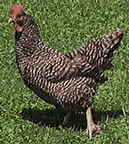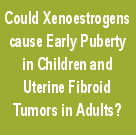|
Ovarian Cyst |
||||||||||||
|
|
||||||||||||
![]()
The Cause of
Ovarian Cyst
Xenoestrogens are Suspected of Causing Ovarian Cysts
Ovarian Cysts are products
of failed or disordered ovulation. A functional ovarian cyst is formed when the follicle does NOT release
its egg, and the follicle continues to grow forming a cyst. An ovarian cyst can also be
formed even if the follicle releases the egg, the hole where the egg is released closes up, the corpus
luteum is NOT formed, and the cyst continues to grow.
It is now believed that xenoestrogens may contribute to ovarian cysts.
by Elizabeth Smith, M.D.
Normal Cycle
Let us
review how a normal menstrual cycle occurs. The hypothalamus is a portion of the brain in the
lower portion of the brain. The pituitary gland is even lower and underneath the brain. 
1. Low levels of estrogen and progesterone stimulate the hypothalamus to send slow pulses of gonadatropin-releasing hormone (GnRH) to the pituitary gland.
2. Stimulated by slow pulses of GnRH, the pituitary sends follicle-stimulating hormone (FSH) to the ovary, which initiates the maturation of ova in follicles. The follicles then produce estrogen.
3. In about 10 days, the high estrogen level signals the hypothalamus to produce fast pulses GnRH. These fast pulses of GnRH tell the pituitary gland to produce luteinizing hormone (LH). Luteinizing hormone (LH) promotes ovulation. The follicle after ovulating turns into the corpus luteum. The corpus luteum produces progesterone. After midcycle, the luteal phase GnRH pulse rate slows dramatically, to levels below that of the follicular phase.
4. The maturing ovarian follicles produce estrogen, which promotes proliferation of ovarian cells. After ovulation, the follicle becomes the corpus luteum (yellow body) and produces progesterone, which becomes the dominant gonadal hormone during the second half of the cycle and converts the proliferative endometrium (lining of the uterus) into secretory endometrium.
5. If pregnancy does NOT occur, the corpus luteum involutes (atrophies) and the production of both estrogen and progesterone falls, a signal for menstruation, and the shedding of the endometrium.
6. Serum levels of estrogen and progesterone fall as they are metabolized and excreted.
7. The fall of estrogen and progesterone stimulates slow pulses of GnRH, starting the cycle anew.
Disordered Ovulation and an Ovarian Cyst is Formed
Your ovaries normally grow cyst like structures called follicles each month. Follicles are little "chemical factories" that produce the hormones estrogen and progesterone and release an egg when you ovulate.
Sometimes a normal monthly follicle just keeps growing. When that happens, it becomes known as a functional cyst. This means it started during the normal function of your menstrual cycle. There are two types of functional cysts:
Hypothesis for Polycystic Ovary Disease (PCOS)
By John Lee, MD
"In the 30 years that I practiced medicine, I rarely saw a woman with polycystic ovary syndrome (PCOS). Today, estimates are that 10 to 20 percent of women have PCOS, and I would guess that among young women the number is even higher, qualifying this as an epidemic.
I have had many e-mails and letters from women in their late teens and twenties with PCOS ( Polycystic ovarian syndrome ). Their doctors tend to prescribe two treatments, both of which affect symptoms only, and neither of which is particularly successful. One treatment is temporary chemical castration, using birth control pills, androgens (male hormones), androgen blockers, synthetic estrogens, Lupron or similar drugs that block hormone production. The other is prescribing the new oral drugs for Type II diabetes, which reduce insulin resistance. I have a much safer, simpler, more effective and less expensive approach that treats the cause and not just the symptoms of PCOS.
What Is PCOS?
PCOS refers to multiple cysts on the ovaries and a host of other problems that go along with them, including anovulation (lack of ovulation) and menstrual abnormalities, hirsutism (facial hair), male pattern baldness, acne, and often obesity. Such women may also have varying degrees of insulin resistance and an increased incidence of Type II diabetes, unfavorable lipid patterns (usually high triglycerides), and a low bone density. Laboratory tests often show higher than normal circulating androgens, especially testosterone.
PCOS ( polycystic ovarian syndrome ) occurs when a woman doesn't ovulate, which causes a disruption in the normal, cyclical interrelationship among her hormones, brain and ovaries. Normally, the hypothalamus, a regulatory center in the brain, monitors the hormone output of the ovaries and synchronizes the normal menstrual cycle. When monthly bleeding ends, the hypothalamus secretes gonadotropin-releasing hormone (GnRH), which stimulates the pituitary gland in the brain to release follicle stimulating hormone (FSH) and luteinizing hormone (LH). These hormones direct an ovary to start making estrogen (mostly estradiol), and stimulate the maturation of eggs in about 120 follicles.
The first follicle that ovulates, releasing its egg into the fallopian tube for a journey to the uterus, quickly changes into the corpus luteum, which is a factory for making progesterone, and raises progesterone's concentrations to 200 to 300 times higher than that of estradiol. This huge surge of progesterone simultaneously puts the uterine lining in its secretory or ripening phase, and turns off further ovulation by either ovary.
If fertilization does not occur, the ovary stops its elevated production of both estrogen and progesterone. The sudden fall in the concentrations of these hormones causes shedding of the blood-rich uterine lining and bleeding (menstruation). Then, in response to low hormone levels, there is a rise in GnRH and the cycle starts all over again.
But what happens to this cycle if, for some reason, ovulation is unsuccessful? For example, if the follicle migrates to the outside of the ovary, but does not "pop" the egg and release it, the follicle becomes a cyst, and the normal progesterone surge does not occur. The lack of progesterone is detected by the hypothalamus, which continues to try to stimulate the ovary by increasing its production of GnRH, which increases the pituitary production of FSH and LH. This stimulates the ovary to make more estrogen and androgens, which stimulates more follicles toward ovulation. If these additional follicles are also unable to produce a matured ovum or make progesterone, the menstrual cycle is dominated by increased estrogen and androgen production without progesterone. This is the fundamental abnormality that creates PCOS.
Why Eggs Won't Pop and Progesterone Isn't Made
But what causes dysfunctional follicles that won't release eggs? I am convinced, from wildlife studies and from what I have observed in my practice, this is due to the exposure of female embryos to xenobiotics, environmental pollutants that chemically act like estrogen on the developing baby's tissues.
When a female embryo develops in the womb, 500 to 800 thousand follicles are created, each enclosing an immature ovum. Studies show that the creation of ovarian follicles during this embryo stage is exquisitely sensitive to the toxicity of xenobiotics. When the mother is exposed to these chemicals, she experiences no apparent damage. But the baby she is carrying is far more susceptible, and these chemicals may damage a female embryo's ovarian follicles and make them dysfunctional; unable to complete ovulation or manufacture sufficient progesterone. This damage is not apparent until after puberty.
Lifestyle Factors that Cause Dysfunctional Follicles
There are other factors that contribute to dysfunctional follicles. These include stress (leading to the production of high cortisol levels by the adrenal glands), lack of exercise, and poor nutrition. Stress alone can cause anovulatory cycles. Birth control pills shut down normal ovary function, and sometimes it never recovers when the pills are stopped. Our diets are full of petrochemical contaminants -- also xenobiotics -- that derail normal metabolism. We take prescription drugs such as Prozac that impair the functioning of our limbic brain, including the hypothalamus, which may affect the menstrual cycle.
The Diet Connection to PCOS
By far the biggest lifestyle contributor to PCOS is poor diet. Young women with PCOS tend to eat far too much sugar and highly refined carbohydrates. These foods cause an unhealthy rise in insulin levels. According to Jerilyn Prior, M.D., insulin stimulates androgen receptors on the outside of the ovary, causing the typical PCOS symptoms of excess hair (on the face, arms, legs), thin hair (on the head), and acne. Eventually, this type of diet will cause obesity, which will cause insulin resistance (the inability of the cells to take in insulin), which will aggravate the PCOS even more. The androgens also play a role in blocking the release of the egg from the follicle.
Women, who have a high number of dysfunctional follicles to begin with, due to xenobiotic exposure in the womb, will have worse problems if their diets are high in sugary foods and low in nutrition. Since this is exactly the type of diet favored by teens and young women, it's easy to understand why there is so much PCOS in that age group. Fifty years ago, the average person age one pound of sugar a year. Today the average teenager today eats one pound a week! Potato chips, corn chips, pasta and white rice are all highly refined carbohydrates that also act on the body much the same as sugars do.
When you look at the whole picture of PCOS, you can understand why the hormone-blocking and insulin-lowering drugs don't work for very long. These approaches don't address the underlying cause of the problem. They only suppress symptoms. Improvement is only temporary and both types of drugs have terribly unpleasant side effects.
By the same token, you can't just take progesterone, and you can't just cut out the sugar. You usually need to do both. Exercise and good nutrition are also very important in maintaining hormone balance, and I have covered both at length in What Your Doctor May Not Tell You About Premenopause.
Treatment of PCOS
I recommend supplementation of normal physiologic doses of progesterone to treat PCOS ( polycystic ovarian disease ). If progesterone levels rise each month during the luteal phase of the cycle, as they are supposed to do, this maintains the normal synchronal pattern each month, and PCOS rarely, if ever, occurs. Natural progesterone should be the basis of PCOS treatment, along with attention to stress, exercise, and nutrition.
If you have PCOS, you can use 15 to 20 mg of progesterone cream daily from day 14 to day 28 of your cycle. If you have a longer or a shorter cycle, adjust accordingly. The disappearance of facial hair and acne are usually obvious signs that hormones are becoming balanced, but to see these results, you'll need to give the treatment at least six months, in conjunction with proper diet and exercise. If your symptoms fade, try gradually easing off the progesterone (take half the dose, for example) and see how it goes. If your symptoms return, stay on the full dose for six more months. Ideally, as a young woman, you would use the progesterone cream only during the months you need it, and encourage your body to return to its own normal hormonal rhythms as much as possible. Some women with many damaged follicles may always need to supplement with a little bit of progesterone cream.
Why Haven't Doctors Figured This Out?
There are several reasons why doctors don't recognize the role of progesterone deficiency in PCOS. They may not be aware that the hypothalamus responds not only to the rise and fall of estrogen, but also to the rise and fall of progesterone. Since standard tests usually indicate that a woman with PCOS has plenty of estrogen, and she is still having periods, the doctor assumes she is still ovulating and producing plenty of progesterone.
The odds of a woman having estrogen dominance and progesterone deficiency rise to 50 percent in the female population by age 35, yet doctors rarely measure progesterone concentrations. They may fear giving progesterone because of all the side effects caused by synthetic progestins, and may not be aware that natural progesterone, unlike synthetic progestins, is remarkably free of side effects when given in normal physiologic doses."
The John R. Lee, M.D. Medical Letter July 1999
Thus, xenoestrogens and other synthetic chemical hormone disrupters have been implicated in Polycystic Ovary disease.
Therefore, avoiding certain chemicals and synthetic products that block or stimulate estrogen and progesterone receptors, MAY help polycystic ovary disease.
Chemical Foreign Estrogens
(Xenoestrogens)
Around the world, there are approximately 100,000
different synthetic chemicals on the market. Some  of
them mimic estrogen in the human body. One
classic estrogen mimic is DDT. In 1950, two Syracuse
University biologists, in an experiment, gave injections of DDT to baby roosters. The roosters grew up looking
like hens. Unfortunately, the U.S. still produces 96 tons of DDT a year (in 1991) and exports it to third world
countries. Then we consume DDT on imported produce. DDT is stored in the fat, notably the breast fat. The
breast fat may concentrate a form of DDT (DDE) up to 700 times
than that of the blood. Blood levels of a form of DDT can typically be measured in the blood at several parts to
tens of parts per billion.
of
them mimic estrogen in the human body. One
classic estrogen mimic is DDT. In 1950, two Syracuse
University biologists, in an experiment, gave injections of DDT to baby roosters. The roosters grew up looking
like hens. Unfortunately, the U.S. still produces 96 tons of DDT a year (in 1991) and exports it to third world
countries. Then we consume DDT on imported produce. DDT is stored in the fat, notably the breast fat. The
breast fat may concentrate a form of DDT (DDE) up to 700 times
than that of the blood. Blood levels of a form of DDT can typically be measured in the blood at several parts to
tens of parts per billion.
When I first saw levels of parts per billion, I thought it was too low to worry about. Unfortunately, our human
body operates on tens of parts per trillion. In other words, some of these chemical estrogens may be found routinely
at levels one hundred times the concentration of our own hormones.
Imagine a baseball glove representing a receptor for estrogen. Think of the glove waiting to catch a ball. DDT
is represented by one hundred shiny plastic balls. One watermelon representing your human estradiol. Which one
does the glove catch?
More Chemical Foreign Estrogens ( Xenoestrogens)
New research by
Soto, M.D. at Tufts University medical school in 1991 showed that chemical additives that make plastics last longer
have estrogen stimulating effects on breast cancer cells in the test tube at parts per billion. Plastic test tubes
with a new plastisizer stimulated breast cancer cells to grow wildly. Stanford University professors found a similar
effect from an additive, bis-phenol A, used in polycarbonate water bottles. Bis-phenol A is also used in dental
filling composites. Spanish researchers
even found that some of the varnish sprayed in food cans (to prevent the "metal" taste) leached into
the food. This slightly tainted food contained more than enough estrogen mimicking chemical to stimulate breast
cancer cells in the test tube to grow rapidly. The above chemicals with estrogen mimicking effects are a class
of chemicals known as alkylphenols.
English
researchers studied a
 profusion of
hermaphrodite trout in the English rivers. They found that
the
sewage effluent draining into the river
contained detergent breakdown products that stimulated estrogen receptors
creating the hermaphrodite trout. Female trout were found in the rivers. No male trout were found - only trout
halfway between male and female.
profusion of
hermaphrodite trout in the English rivers. They found that
the
sewage effluent draining into the river
contained detergent breakdown products that stimulated estrogen receptors
creating the hermaphrodite trout. Female trout were found in the rivers. No male trout were found - only trout
halfway between male and female.
Some
alligator populations are having
trouble reproducing because the male penises are too small (blush!). The
female alligator ovaries had used up all their eggs prematurely ("burned
out"). Could these female alligators have Polycystic Ovary Disease?
Researchers have implicated chemical hormone disrupters.
Agricultural Foreign Estrogens
Agriculture typically uses artificial
estrogen compounds to fatten up cattle and chicken quickly. Estrogen also stimulates the retention of water giving
a heavier weight and tender meat. Some proponents say that the artificial estrogen compounds disappear from the
urine in a matter of days and the animals are then free of artificial hormones. Other opponents say the artificial
estrogens are stored in the fat and then eaten by consumers. The European Union has banned U.S. and Canadian beef
from entering the E.U. for 12 years citing estrogen in the meat and the probable increase of breast cancer. Are
they right? Or merely being protectionist as the U.S. claims.
In 1970's and 1980's, an epidemic of early puberty girls as young as a year old in Puerto Rico began menstruating
after eating meat and dairy products with high amounts of estrogens. Some young boys developed breasts.
15% Girls aged 8 sprouting pubic hair and breast buds?
Women are now beginning to menstruate in the
United States at age 10. The age of menarche used to be 16. Authorities have insisted that this is normal for a
population with good nutrition. Is it? Herman-Giddons in a landmark study done in 1997 published in Pediatrics
showed that out of 17,000 girls, 15% aged 8 years old began to show signs of puberty in the United States. See
the Time
Magazine article! The Time Magazine
article points a finger at chemicals in our environment that mimic estrogen.
Chemical Phobia?
One
study showed that elevated levels of
DDT and PCB were not markedly higher in women that had breast cancer. An editorial
confidently labeled the new concerns as chemical phobia. However, these are only two chemicals. We don't know much
about chemical interactions nor all the other chemicals which are as yet untested.
The Bottom Line
In the last 5-10 years, new research
has shown that certain chemicals in modern society do mimic estrogen in the test tube. These chemicals can come
from sources that we previously thought were inert such as plastics that might be used to package food and detergents.
Some animals
in the environment also show evidence
of hormone
disruption.
Presently, we do not know what these test tube studies mean for us. Human bodies can act differently. Unfortunately,
only a small fraction of chemicals have been tested for estrogen mimicking effects, and these chemicals are active
at infinitesimal small quantities way below what was previously thought to affect humans. Estrogen mimicking chemicals
can also act synergistically to amplify each other or even block each other. This is widely known, but exact synergistic
reactions and levels at which they occur are virtually unknown.
Chemicals in our environment having estrogenic effects known as xenoestrogens are now being investigated by the Environmental Protection
Agency. Read more about Endocrine Disruptors at Theo Colborn's Organization "The Endocrine Disruptor Exchange.".


